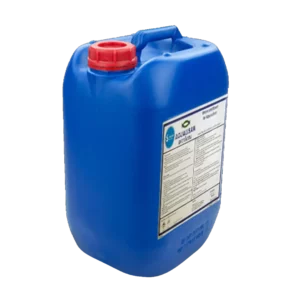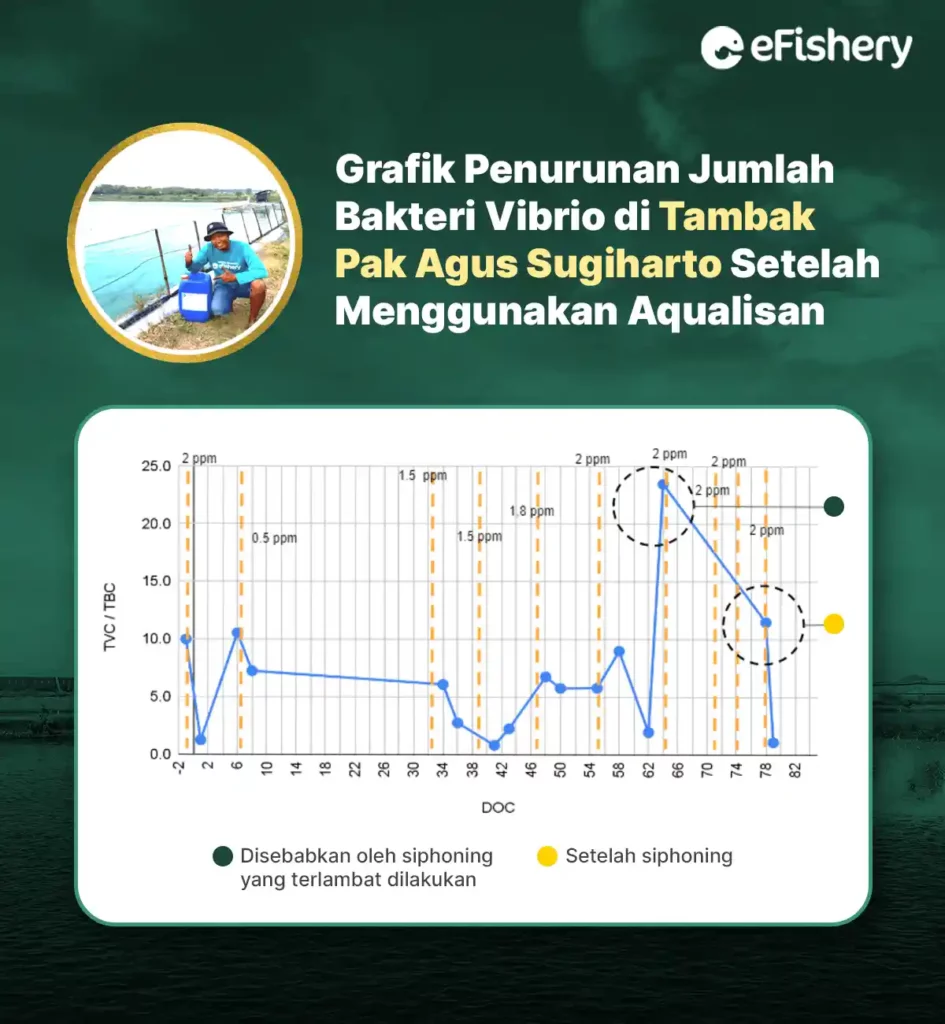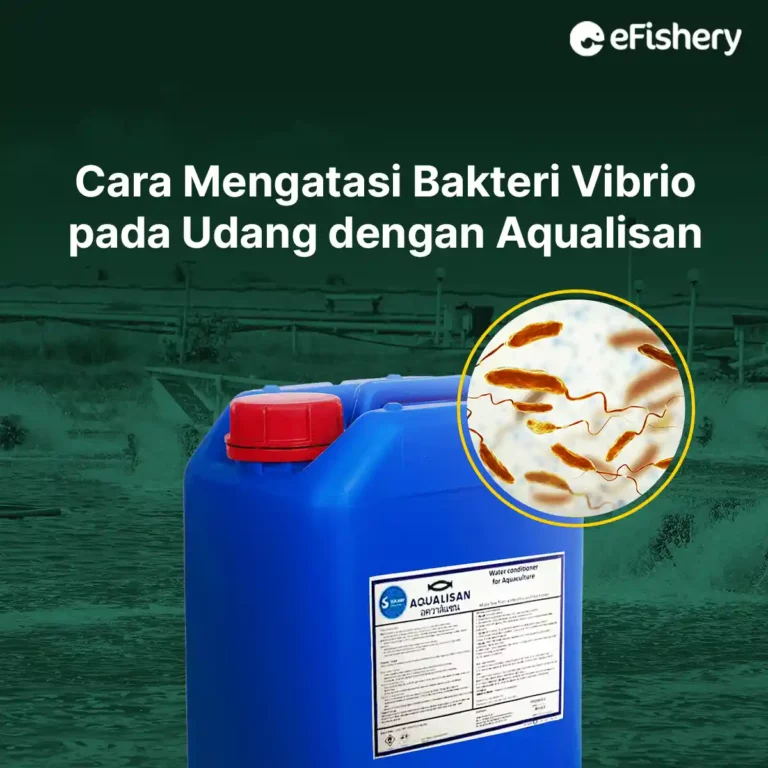Artikel Ini Telah Direview Oleh:

Sangga Sulistyo
Praktisi Aquaculture
Attack of vibrio bacteria on shrimp is one of the causes of mass death of shrimp and crop failure. This bacterial attack is quite dangerous because until now there is no way to deal with vibrio bacteria in ponds other than taking precautions. For a more complete explanation, see the following description.
Types of Vibrio Bacteria in Ponds
There are 4 types of vibrio bacteria that commonly infect shrimp, namely:
1. Vibrio harveyi
This bacterium is a bacterium that causes WSSV disease which worries shrimp farmers because it can cause shrimp death of up to 80% in a few days.
2. Vibrio alginolyticus
This bacterium is the cause of bacterial disease that infects shrimp larvae. Larvae infected by these bacteria will appear to glow in dark conditions. This bacterial disease is commonly found during the rainy season, when the salinity drops and there are drastic pond water temperature differences.
3. Vibrio parahaemolyticus
This bacterium is the cause of AHPND or EMS disease which causes death in shrimp with a mortality of up to 100%. Death due to AHPND occurred at the initial DOC maintenance, which was less than 40 days.
4. Vibrio anguillarum
This bacterium is capable of infecting freshwater shrimp. Despite the ability to infect V. anguillarum lower than other vibrios, ability V. anguillarum in infecting shrimp can increase to a mortality rate of 100% when the stocking density of shrimp is too high.
Maximum Limit of Vibrio Bacteria in Ponds
The abundance of vibrio bacteria needs to be watched out for, especially in ponds based on soil sediment, pond water, and shrimp bodies. Safe limit of bacterial abundance Vibrio sp. in water is 102-103 CFU/ml. If there is an abundance of vibrio bacteria reaching 104 CFU/ml, the condition of your pond waters is at a critical stage. One of the steps that need to be taken is to immediately harvest so that the infection does not spread widely.
How to Suppress the Number of Vibrio Bacteria
As mentioned above, there is no optimal way to cure shrimp disease caused by vibrio bacteria. The best way to protect your shrimp from disease is to prevent the vibrio bacteria from entering your shrimp pond.
Here's how to reduce the abundance of vibrio in aquaculture water:
- Give the right probiotics and according to the dose. This step can suppress the population of pathogenic bacteria because probiotic bacteria are able to produce anti-bacterial materials for immune response, especially for shrimp growth.
- Cleaning the pool, such as by siphoning or removing water containing silt.
- Maintain optimal water quality. Optimal water quality can prevent shrimp from stress, so that shrimp are not susceptible to disease.
- Replace the water that has been treated as a disinfectant. One of the recommended disinfectants to suppress the growth of pathogens is Aqualisan.
How to Suppress the Growth of Vibrio Bacteria with Aqualisan

Aqualisan is an environmentally friendly disinfectant which is very useful for suppressing the growth of pathogenic bacteria and maintaining water quality in ponds.
The use of Aqualisan in shrimp ponds has the following benefits:
- Kills and controls harmful bacteria, viruses and microbes.
- Dissolves immediately in water and is harmless to shrimp.
- Ensuring the safety of biosecurity in ponds by killing and weakening disease, controlling the spread of disease, and preventing disease transmission.
Aqualisan's superiority was proven by one of the shrimp farmers from Purworejo, East Java, namely Pak Agus Sugiharto.

The graph above is the result of observations on Pak Agus' pond. The results obtained were a decrease in bacteria in the ponds after application of Aqualisan at a dose of 0.5-2 ppm. However, after DOC 62, there was an increase in the number of bacteria because the farmers were late in siphoning. After applying Aqualisan and siphoning, the number of bacteria in the ponds decreased again.
In conclusion, using a disinfectant such as Aqualisan can help you reduce the number of vibrio bacteria in the pond. However, pond maintenance steps such as siphons also still have an important role, so they should not be missed because they can trigger high bacteria in pond ponds.
Here's how to use Aqualisan:
- Dosing at night (when there is no sunlight). Make sure the dosing does not coincide with the hours of giving probiotics.
- Place the dosing on the anco bridge.
- The following is the recommended Aqualisan dosage:
– Ground pond: 4 ppm during the cultivation period
– HDPE, plastic, mulch or concrete ponds: 0.5-2 ppm, adjusted to water quality conditions during cultivation - Don't forget to siphon the pond to suppress the growth of bacteria at the bottom of the pond.
Dapatkan Bantuan untuk Mengatasi Vibrio bersama Ahli Budidaya!
Need Help Regarding Shrimp Cultivation Business?
Fill in your personal data in the following form. Our team will immediately contact you via the number cellphone attached. Make sure the data entered is correct.
Bakteri vibrio menjadi salah satu bakteri patogen yang mengancam proses budidaya. Udang yang terinfeksi bakteri ini akan mengalami kematian massal dan menimbulkan kerugian ekonomi yang cukup tinggi.
Jika Bapak/Ibu ingin langsung berkonsultasi dan mendapatkan rekomendasi terkait cara mengatasi bakteri vibrio di tambak udang, Bapak/Ibu bisa langsung mengakses fitur Cultivation Consultation in app eFarm secara GRATIS. Bapak/Ibu akan berkonsultasi langsung dengan Ahli Budidaya eFishery dan mengetahui tips menarik lainnya seputar budidaya udang.
Fill out the form above to consult at Cultivation Consultation secara FREE!

Sangga Sulistyo - Praktisi Aquaculture
Sangga adalah praktisi Aquaculture yang memulai karirnya pada tahun 2003 dan sekarang menjadi Technical Support Manager eFishery untuk seluruh wilayah Indonesia
Questions Regarding Overcoming Vibrio with Aqualisan
One way to deal with Vibrio bacteria is to apply the environmentally friendly Aqualisan disinfectant through dosing at night. Make sure you have consulted the dosage with a shrimp farming expert.
One of the recommended disinfectants to suppress the growth of pathogens is Aqualisan, an environmentally friendly disinfectant product. Aqualisan is very useful for suppressing and killing the growth of pathogenic bacteria and maintaining water quality in ponds.
- Anjasmara, B., PGS Juliantoro and EW Suryaningtyas. 2018. Total Bacteria and Vibrio Abundance in Vannamei Shrimp Culture (Litopenaeus vannamei) Closed Recirculation System with Different Stocking Densities. Current Trends in Aquatic Science. I (1): 1-7.
- Ayini, U., S. Harnina and TC Dewi. 2014. Antibacterial Effects of Neem Leaf Extract (Azadirachta indica A. Juss) Against Vibrio algynoliticus Bacteria in Vitro. Bioscientific. 6(1): 67- 75.
- Bintari, NWD, R. Kawuri and AAGR Dalem. 2016. Identification of Vibrio Bacteria Causing Vibriosis in Giant Prawn Larvae (Macrobrachium rosenbergii (de Man)). Biology Journal. 20(2):53-58.
- Ishmael. 2019. Control of Infectious Myo Necrosis Virus (IMNV) in Raising Vaname Shrimp (Litopenaeus vannamei Boone) Intensive System Ponds at CV. Untung Jaya Probolinggo, East Java. Thesis. 36 p.
- KKP. Watch out for bacterial attacks on shrimp. 4 p.
- Mustafa, MF, M. Bunga and M. Ahmad. 2019. The Use of Probiotics to Suppress the Population of Vibrio sp. In Vaname Shrimp (Litopenaeus vannamei) Cultivation. Journal of Fisheries and Marine Science. 2(2):69-76.
- Rusadi, D., Wardiyanto and R. Diantari. 2019. Treatment Of Vibriosis Disease (Vibrio harveyi) In Vaname Shrimp (Litopenaeus vannamei, Boone 1931) Using Avicennia alba Leaves Extract. e-Journal of Aquaculture Engineering and Technology. VIII(1): 909-916.
